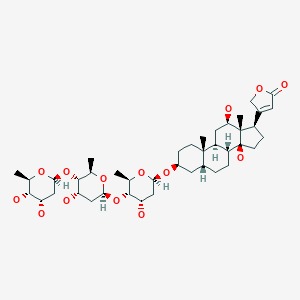Attribution Statement: LactMed is a registered trademark of the U.S. Department of Health and Human Services.
NCBI Bookshelf. A service of the National Library of Medicine, National Institutes of Health.
Drugs and Lactation Database (LactMed®) [Internet]. Bethesda (MD): National Institute of Child Health and Human Development; 2006-.
CASRN: 20830-75-5

Drug Levels and Effects
Summary of Use during Lactation
Because of the low levels of digoxin in breastmilk, amounts ingested by the infant are small and would not be expected to cause any adverse effects in breastfed infants. If the mother is to receive digoxin intravenously, avoidance of breastfeeding for 2 hours after the dose will lessen the dose the infant receives.
Drug Levels
Maternal Levels. In 11 women taking digoxin 0.25 mg daily orally, milk digoxin levels obtained on days 3 to 7 postpartum were relatively constant at 0.644 mcg/L.[1] The amounts in milk represent an infant dosage of about 2.3% of the maternal weight-adjusted dosage or 0.097 mcg/kg daily, which is about 1% of the neonatal maintenance dosage.
Milk digoxin levels were 0.41 and 0.78 mcg/L in two mothers taking oral digoxin 0.25 mg daily.[2]
Milk digoxin levels ranged from undetectable (<0.5 mcg/L) to 1 mcg/L in 5 women treated with unspecified doses of digoxin. Milk and serum levels were similar.[3]
A milk digoxin level of 1.9 mcg/L was measured in a mother taking 0.75 mg daily of digoxin during pregnancy and postpartum.[4]
After an intravenous bolus dose of digoxin 0.5 mg in 11 women, digoxin serum and milk levels rapidly equilibrated, with high levels occurring rapidly, dropping to low levels by about 2 hours after the dose. A pharmacokinetic simulation using data from these mothers indicate that a fully breastfed infant would obtain a serum level of only about 3% of a therapeutic level with maternal intake of 0.5 mg daily of digoxin.[5]
Infant Levels. In two breastfed infants whose mothers were taking oral digoxin 0.25 mg daily, digoxin was undetectable (< 0.1 mcg/L) in their serum after 10 days of maternal therapy.[2]
A mother took 0.75 mg daily of digoxin during pregnancy and postpartum. Her infant had a serum level of 0.2 mcg/L after nursing for 7 days, having decreased from a level of 0.6 mcg/L at birth.[4]
Effects in Breastfed Infants
At least 4 infants have been reported to have been breastfed in studies on digoxin in breastmilk. None had any detectable digoxin effect.[2][4][6]
Effects on Lactation and Breastmilk
Relevant published information was not found as of the revision date.
References
- 1.
- Chan V, Tse TF, and Wong V. Transfer of digoxin across the placenta and into breast milk. Br J Obstet Gynaecol. 78;85:605-9. [PubMed: 687540]
- 2.
- Loughnan PM. Digoxin excretion in human breast milk. J Pediatr. 78;92:1019-20. [PubMed: 660341]
- 3.
- Levy M, Granit L, Laufer N. Excretion of drugs in human milk. N Engl J Med. 1977;297:789. Letter. [PubMed: 895815]
- 4.
- Finley JP, Waxman MB, Wong PY et al. Digoxin excretion in human milk. J Pediatr. 1979;94:339-40. Letter. [PubMed: 762640]
- 5.
- Reinhardt D, Richter O, Genz T et al. Kinetics of the transplacental passage of digoxin from breast feeding mothers to their infants. Eur J Pediatr. 1982;138:49-52. [PubMed: 7075628]
- 6.
- Miller MR, Withers R, Bhamra R et al. Verapamil and breast-feeding. Eur J Clin Pharmacol. 1986;30:125-6. [PubMed: 3709626]
Substance Identification
Substance Name
Digoxin
CAS Registry Number
20830-75-5
Drug Class
- Breast Feeding
- Antiarrhythmics
- Cardiac Glycosides
Disclaimer: Information presented in this database is not meant as a substitute for professional judgment. You should consult your healthcare provider for breastfeeding advice related to your particular situation. The U.S. government does not warrant or assume any liability or responsibility for the accuracy or completeness of the information on this Site.
- User and Medical Advice Disclaimer
- Drugs and Lactation Database (LactMed) - Record Format
- LactMed - Database Creation and Peer Review Process
- Fact Sheet. Drugs and Lactation Database (LactMed)
- Drugs and Lactation Database (LactMed) - Glossary
- LactMed Selected References
- Drugs and Lactation Database (LactMed) - About Dietary Supplements
- Breastfeeding Links
- PubChem SubstanceRelated PubChem Substances
- PubMedLinks to PubMed
- Review Azithromycin.[Drugs and Lactation Database (...]Review Azithromycin.. Drugs and Lactation Database (LactMed®). 2006
- Review Erythromycin.[Drugs and Lactation Database (...]Review Erythromycin.. Drugs and Lactation Database (LactMed®). 2006
- Carbohydrates from Cynanchum otophyllum.[Carbohydr Res. 2004]Carbohydrates from Cynanchum otophyllum.Zhao YB, Shen YM, He HP, Li YM, Mu QZ, Hao XJ. Carbohydr Res. 2004 Aug 2; 339(11):1967-72.
- Review Tobramycin.[Drugs and Lactation Database (...]Review Tobramycin.. Drugs and Lactation Database (LactMed®). 2006
- Review Telithromycin.[Drugs and Lactation Database (...]Review Telithromycin.. Drugs and Lactation Database (LactMed®). 2006
- Digoxin - Drugs and Lactation Database (LactMed®)Digoxin - Drugs and Lactation Database (LactMed®)
Your browsing activity is empty.
Activity recording is turned off.
See more...
